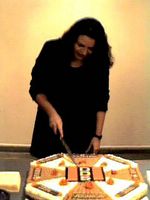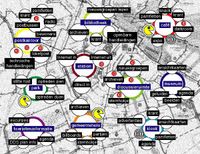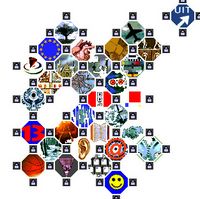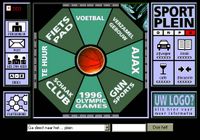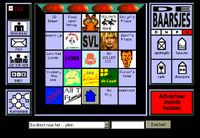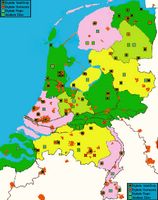This is are-run of a blog I wrote in 2007, which reflects my attitude towards the European Union. Will you vote tomorrow?
Wednesday, May 09, 2007
Europe Day
 Today it is the Day of Europe. Normally it is a day on which attention is asked for Europe, the unity and policies. But this year it is 50 years ago that in Rome on March 24, 1957a treaty for economic co-operation was signed by Belgium, Germany, France, Italy, Luxembourg and The Netherlands. (see the story below).
Today it is the Day of Europe. Normally it is a day on which attention is asked for Europe, the unity and policies. But this year it is 50 years ago that in Rome on March 24, 1957a treaty for economic co-operation was signed by Belgium, Germany, France, Italy, Luxembourg and The Netherlands. (see the story below).Since high school I have known that I was living in Europe. Our family was living close to the German border and my boarding school was close to the Belgian border. During my period as a managing editor for a reference department, I was working with a Belgian publishing company in Antwerp. And from the early eighties I worked in the United Kingdom in London for the VNU publishing company.
 In 1980 I took notice of the new EC datanetwork Euronet-Diane, which was introduced in The Netherlands in 1980 (with Ms Kroes, the present competition minister, who was a minister of Transport and Communication at that time). (See photograph). But by 1982 I got in touch with the European Commission. I met an EC official in London during a dinner of the Online Conference. He was part of the research department Directorate General XIII in Luxembourg. We stayed in contact and by 1983 I applied for a grant to introduce a daily electronic newsletter for the computer industry. It was to be an electronic counterpart to the printed newsletter. The grant of 60.000 ecu (roughly the same as euro) was awarded and the daily electronic newsletter was launched on December 1, 1984 and turned out to be the first electronic daily newsletter in Europe.
In 1980 I took notice of the new EC datanetwork Euronet-Diane, which was introduced in The Netherlands in 1980 (with Ms Kroes, the present competition minister, who was a minister of Transport and Communication at that time). (See photograph). But by 1982 I got in touch with the European Commission. I met an EC official in London during a dinner of the Online Conference. He was part of the research department Directorate General XIII in Luxembourg. We stayed in contact and by 1983 I applied for a grant to introduce a daily electronic newsletter for the computer industry. It was to be an electronic counterpart to the printed newsletter. The grant of 60.000 ecu (roughly the same as euro) was awarded and the daily electronic newsletter was launched on December 1, 1984 and turned out to be the first electronic daily newsletter in Europe.Ever since that project I have been involved in European projects, sometimes as a researcher or project participant, sometimes as an evaluator and reviewer of projects. In 1993 in the early days of multimedia CD-ROMs I was asked to write a report on CD-Data. In 2002 my company was involved in the ACTeN project a fully funded content project, which lasted two years. It took me around Europe for round table meetings, summer schools and lectures; besides the consortium generated one of the scarce books on content E-Content – Technologies and Perspectives for the European Market (2005).
It has been difficult for the European Commission to execute a coherent policy. This has to do with the division of tasks. ICT and especially digital media have different programmes: research, media and regional programmes.
An improvement in this fragmentation was the merger of the research programme IST with the EU Media programme. With coordination between research and close to the market projects results can be improved. The EU Media programme still has to be less dogmatic as to movies and interactive media as digitisation is influencing the production chain.
But these programmes (IST, EU Media and regional) can also be confusing to companies and especially Small and Medium sized Enterprises (SMEs). Especially since the EC started to introduce again big projects, in which companies like Philips, Nokia and BBC participate. Officially these companies should take in the consortium SMEs, but in practice this proves to be difficult. For an SME it is difficult to get in programmes as they are asked for accounts of three years and will have to do a lot of administration.
And not all consortia work. Only yesterday Germany in its function of presiding country noticed that the satellite navigation project Galileo had lost its way; head-banging did not help any longer, so another route had to be searched for.
 Despite the political problems and programme problems, I am glad that there is a European Union. I personally think of myself as a European rather than a Dutchman.
Despite the political problems and programme problems, I am glad that there is a European Union. I personally think of myself as a European rather than a Dutchman.(Preparing the blog I read the story that the Treaty of Rome was signed on 180 pages of blank pages in 1957. The printer of the Treaty was unable to finish the assignement in time for the signing ceremony. On the day of signing, the ministers were requested to sign pages without any text. The story was told by Professor Hendrik Vos of Gent University on 22 March 2007.)





